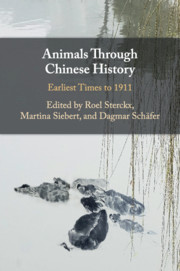Figures
1.1Ox scapula Shang oracle bone (Heji 19813 recto: Early Wu Ding period) .
1.4Shang oracle bone inscription (Heji 32125: Post Wu Ding period).
1.5A Shang period ritual tripod cauldron with bovine taotie images. From An Exhibition of Chinese Bronzes (C.T. Loo & Co., New York, 1939), pl. IV, no.8.
6.1Grain-mill powered by two mules. Illustration from [Wang Zhen] Nongshu, ‘Nongqi tupu’ 9, 284.
6.2Grand ancestral sacrifice, with a pig and a chicken as offerings. Nakagawa Shundai (ed.), Shinzoku kibun [Recorded Accounts of Qing Customs], Tōto [Edo], Nishimiya Tasuke, Kansei 11 [1799] shinsen, 12.2a–3b. Online resource, Staatsbibliothek zu Berlin – PK, http://resolver.staatsbibliothek-berlin.de/SBB0000B38700000000
8.1Herdsman on the back of an ox, Mu niu tu juan 牧牛圖卷, by Mao Yi 毛益 (12th century). Photo by Hu Chui 胡錘. Courtesy of the Palace Museum, Beijing.
10.1One of the ‘Four Steeds of Aiwuhan [Afghan]’ by Giuseppe Castiglione, 1762. (The Collection of the National Palace Museum, Taipei).
11.1Kangxi’s antler paired with Qianlong’s essay. ‘Two Paintings of Deer Antlers’ section 2-b. The Metropolitan Museum of Art, New York.
11.2Falconers in Republican Beijing (between 1917 and 1919). ‘Men and Falconers (item ID RL_10074_LS_0157) by Sidney Gamble. (Sidney D. Gamble Photographs, David M. Rubenstein Rare Book and Manuscript Library, Duke University).
11.3Note written on the title page of Gu Deji’s poetry (Siku quanshu cunmu congshu: Ji bu, 195.344).

